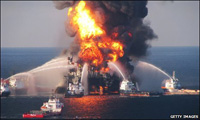 I don’t watch a lot of television, though it seems every time that I turn the set on I see another commercial touting how wonderful things are on the Gulf of Mexico. The sun is shining, the beaches are beautiful, and the food is tasty. The commercials are intended to attract tourists dollars to the Gulf Coast and they are all paid for by BP. There are other commercials where BP employees address the camera to talk about their commitment to the Gulf and all the good and wonderful things that they and the company are doing. There is no mention, of course, of BP’s Deepwater Horizon spill that killed eleven workers and spilled an estimated 4.9 million barrels of crude oil into the Gulf. It was the largest accidental marine oil spill in the history of the petroleum industry.
I don’t watch a lot of television, though it seems every time that I turn the set on I see another commercial touting how wonderful things are on the Gulf of Mexico. The sun is shining, the beaches are beautiful, and the food is tasty. The commercials are intended to attract tourists dollars to the Gulf Coast and they are all paid for by BP. There are other commercials where BP employees address the camera to talk about their commitment to the Gulf and all the good and wonderful things that they and the company are doing. There is no mention, of course, of BP’s Deepwater Horizon spill that killed eleven workers and spilled an estimated 4.9 million barrels of crude oil into the Gulf. It was the largest accidental marine oil spill in the history of the petroleum industry.
If the commercials do not mention the spill, it is the center of conversation in a civil trial that began last week where BP may face up to another $17 billion in penalties and fines. This in addition to the $4.5 billion criminal settlement in which BP pleaded guilty to eleven felonies last year.
BP Facing Up to $17 Billion in Penalties in Civil Trial
Even if the commercials say that all is well in the Gulf, that is not the case for whales and dolphins. The Northern Gulf of Mexico is now in year three of a Cetacean Unusual Mortality Event. As of February 24, 2013, the event involves 872 Cetacean “strandings” in the Northern Gulf of Mexico (5% stranded alive and 95% stranded dead). Scientists do not know what is killing the whales and dolphins. The period, at first glance, appears to overlap neatly with the Deepwater Horizon spill, but began slightly before the spill, with approximately 100 whales or dolphins stranded between February and April of 2010. There has been no direct tie between the dying whales and dolphins and the oil, yet many scientists believe that thew spill contributed to the increase deaths.
2010-2013 Cetacean Unusual Mortality Event in Northern Gulf of Mexico
